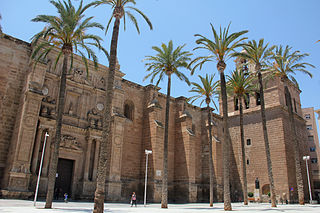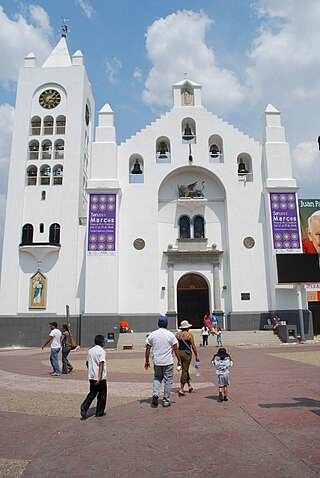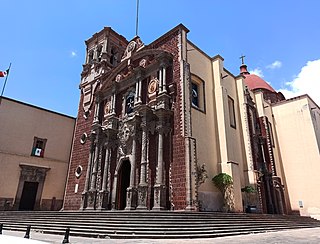Tlalnepantla is the name of a city and a municipality in the Mexican state of Morelos.

Rioverde is a city and its surrounding municipality located in the south-central part of the state of San Luis Potosí, Mexico. It is the fifth-most populated city in the state, behind San Luis Potosí, Soledad de Graciano Sánchez, Ciudad Valles, and Matehuala. It is the agricultural, economic, turistic and demographic most important core in the Zona Media, one of the four geographical divisions of the state. The city had a 2005 census population of 49,183, while the municipality, of which it serves as municipal seat, had a population of 85,945 and an area extent of 3,064 km². The population of its metropolitan area, which includes the largest municipality of Ciudad Fernández, was 126,997.

Tlalnepantla de Baz is one of 125 municipalities of the state of Mexico, north of Mexico City. The municipal seat and largest city in the municipality is the city of Tlalnepantla. Tlalnepantla comes from the Náhuatl words tlalli (land) and nepantla (middle) to mean the middle land. The city was known in prior times as Tlalnepantla de Galeana and Tlalnepantla de Comonfort, to honor Hermenegildo Galeana and Ignacio Comonfort, respectively. The current addition of Baz comes from the last name of Gustavo Baz Prada, an important politician and soldier of Emiliano Zapata's army during the Mexican Revolution. After the Revolution, Baz Prada became Governor of the State of Mexico and President of the National Autonomous University of Mexico (UNAM). It is located in the northeastern part of the state of Mexico, in the Valley of Mexico north of Mexico City proper. Together with Atizapán, it comprises the dense Region XII of Mexico State.

The Eje Central or Avenida Lázaro Cárdenas is an avenue in the Cuauhtémoc and Gustavo A. Madero boroughs of Mexico City, Mexico. It is part of a system called eje vial of roadways built by Carlos Hank González to modernize Mexico City for improved traffic flow through the city. As its name indicates, it runs through the central zones of the city, starting at Río de los Remedios Avenue and ending at Río Churubusco Avenue, near Eje Central metro station.

The Cathedral of Almería, in full the Cathedral of the Incarnation of Almería, is a Roman Catholic cathedral in the city of Almería, Andalusia, Spain. It is the seat of the Roman Catholic Diocese of Almería.

The Immaculate Conception Cathedral, also Celaya Cathedral, is the main Catholic building in the city of Celaya in Mexico, occupying at present what was the space of a chapel annexed to the Temple of St. Francis. Because of the size of this last temple, it has come to confuse the Temple of St. Francis with the cathedral, a common mistake.

St. Mark's Cathedral, or also known as Tuxtla Gutiérrez Cathedral, is a Catholic church in Tuxtla Gutierrez, Chiapas, Mexico, and seat of the Roman Catholic Archdiocese of Tuxtla.

The St. Mary of the Assumption Cathedral is the main Catholic church of the city of Chilpancingo in Mexico. It is consecrated to the Virgin Mary in its invocation of St. Mary of the Assumption and has been the episcopal seat of the Diocese of Chilpancingo-Chilapa for some years, since it was previously located in the city of Chilapa de Álvarez. It is located in the downtown area within the architectural and historical complex that occupies the First Congress of Anahuac Civic Square. Its construction took place at the end of the 18th century and beginning of the 19th century.

The St. Joseph and St. Andrew Cathedral is a Catholic church in the Diocese of San Andrés Tuxtla located in the city of San Andrés Tuxtla, in Veracruz, Mexico. It dominates the center of the town with its two towering sotaventino Colonial-style towers. The beginning of its construction dates to the late nineteenth and mid-twentieth century.

The St. Bonaventure Cathedral is a Catholic church, part of the convent of the same name in the Municipality of Cuautitlán, State of Mexico. It was designated as a cathedral on February 5, 1979, with the founding of the Diocese of Cuautitlán.

The St. Philip Neri Cathedral, also Querétaro Cathedral, is a Catholic church that was built by the Oratory of Saint Philip Neri. It is located in the center of the city of Santiago de Querétaro in Mexico.

The Our Lady of Guadalupe Cathedral is a Catholic church that serves as the headquarters of the Diocese of Huajuapan de Leon in Mexico since 1903. The building is located in the center of the city of Huajuapan de Leon, in the state of Oaxaca.

The Sacred Heart of Jesus Cathedral, also Ecatepec Cathedral, is the main Catholic church and seat of the Diocese of Ecatepec in Mexico. It is dedicated to the Sacred Heart of Jesus. It is located in the municipality of Ecatepec, in the State of Mexico.

The Cathedral Basilica of Our Lady of the Rosary, also known as Culiacán Cathedral, is the Catholic cathedral that serves as the headquarters of the diocese of Culiacán, Mexico, although it is not the oldest temple in the municipality, since it dates from 1842. The oldest are the Tabalá and Tacuichamona temples.

The St. Joseph Cathedral Also Ciudad Guzmán Cathedral It is a Catholic cathedral in Mexico that serves as the mother church of the Roman Catholic Diocese of Ciudad Guzmán and the seat of its bishop. Built at the end of the 19th century, it was completed around 1900.

The Immaculate Conception Cathedral Also Texcoco Cathedral is a Catholic cathedral that is located in the former convent that the Franciscans built in the 16th century in the town of Texcoco in Mexico. This is one of the first complex conventions that the Franciscan order built on lands of the new world, to carry out the process of evangelization.

The Our Lady of the Assumption Cathedral is a Catholic church located in the city of Teziutlán, Mexico. Formerly it was a hermitage dedicated to St. Michael the Archangel, and later became Chapel of the Rosary. On June 19, 1931, the parish was elevated to a cathedral, on the occasion of the change of episcopal seat passing from the city of Papantla to Teziutlán, leaving as the first bishop of the Diocese of Papantla the Hon. Mr. Nicolás Corona.

The Holy Trinity Cathedral Also Autlán Cathedral Is a religious building of the Catholic Church that functions as the headquarters of the Diocese of Autlán in Mexico. Raised in the late nineteenth century, the structure had a slow build.

Braulio Caballero-Figueroa, is a Mexican organist, harpsichordist and orchestral conductor. He was organist of the Metropolitan Cathedral of Mexico City.





















